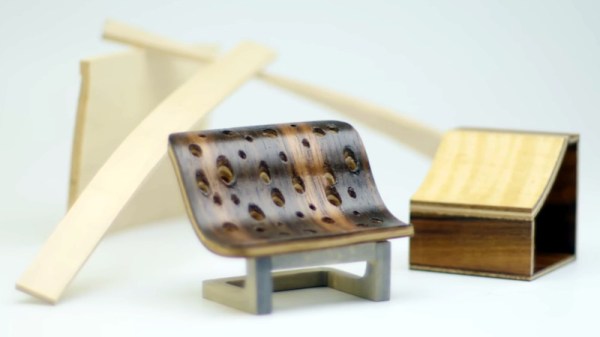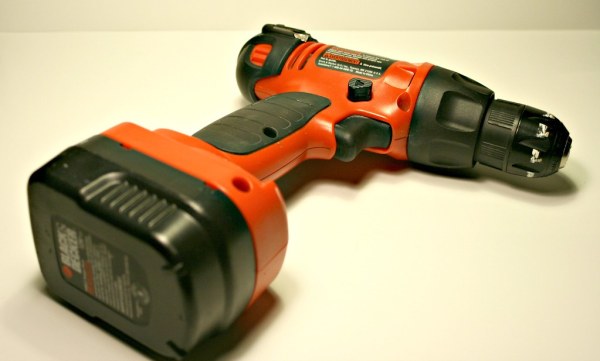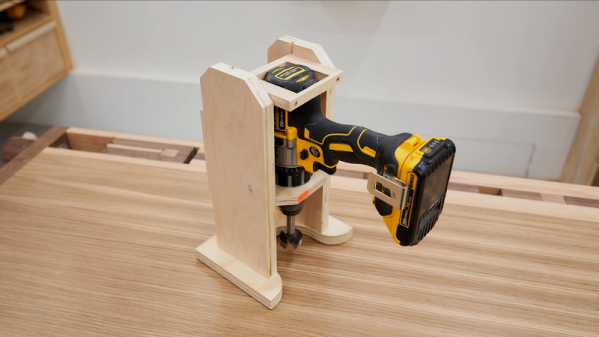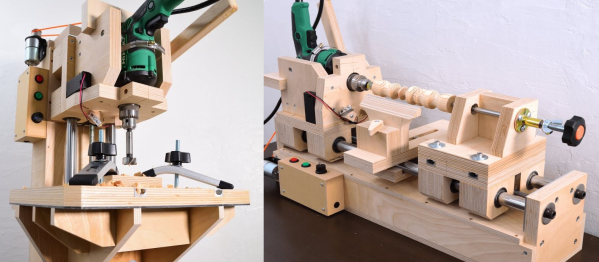Companies now are looking to secure revenue streams by sneakily locking customers into as many recurring services as possible. Subscription software, OS ecosystems, music streaming, and even food delivery companies all want to lock consumers in to these types of services. Battery-operated power tools are no different as there’s often a cycle of buying tools that fit one’s existing batteries, then buying replacement batteries, ad infinitum. As consumers we might prefer a more open standard but since this is not likely to happen any time soon, at least we can build our own tools that work with our power tool brand of choice like this battery-powered soldering station. Continue reading “Soldering Station Designed Around Batteries”
power tools17 Articles
Brick And Motor Table Saw Delivers Paper Cuts On Demand
Twenty Two Motors. Fifty gears. Eighty Two Hundred RPM. Hundreds of individual pieces, and one sheet of glossy paper cut into a disk. This isn’t a nightmare driven Rube Goldberg machine. Instead, it’s a Lego monstrosity created by [GazR] of [GazR’s Extreme Brick Machines!], and all of these parts are flying in formation for one Lego slicing purpose. In the video below the break, you can see what very well may be the worlds most powerful Lego and Paper table saw.
Starting out with a build that had a mere fourteen motors in a platform that looked quite a lot more like a table saw, [GazR] learned that having only fourteen motors turning a Lego based blade was not a good combination. In the next iteration, the same number of motors were used, but the gearing was increased to bring RPM up, and a Lego toy saw blade took care of cutting duties.
Seeing that higher speeds with thinner blades was a winning trend, [GazR] stepped it up to the aforementioned 8200 RPM twenty-two motored paper whirling Lego Death Machine. Yes, [GazR] cut Lego, carrots, carpet, and paper- all with circular sheet of paper.
Do Lego mechanisms turn your gears? You might enjoy this Legopunk Orrery from the Hackaday archives, too. Thanks to [Keith] for the great tip. Be sure to submit your own tips via the Hackaday Tips Line, or the #Submit-A-Tip channel in the Hackaday Discord server.
Continue reading “Brick And Motor Table Saw Delivers Paper Cuts On Demand”
How To Get Good With Wood
It’s perhaps unsurprising that we don’t see much in the way of woodworking here at Hackaday; after all, this is a plastics and metal community if there ever was one. But that doesn’t mean you’ll never come across a situation where a dead tree needs to be cut or shaped to your will, so we appreciate [Eric Strebel] demonstrating some tips and best practices for working with this exceptionally versatile building material.
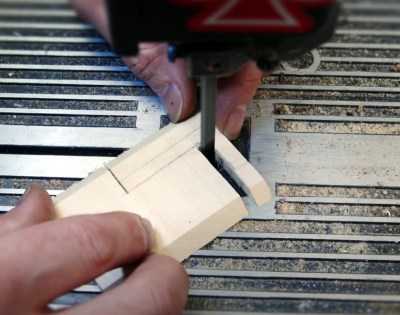 The first video assumes you’re a lumber neophyte, and goes over topics such as the different species of wood you’re likely to find at the hobby shop, proper sanding technique, and the differences between cutting with and against the grain. Some of the different cutting tools you can use are also covered, ranging from the humble hobby knife to the band saw. As always, [Eric] sprinkles the video with tips and tricks gained from his considerable professional experience, such as using some glue and a bit of sawdust to fill in any gaps left behind by an uneven joint.
The first video assumes you’re a lumber neophyte, and goes over topics such as the different species of wood you’re likely to find at the hobby shop, proper sanding technique, and the differences between cutting with and against the grain. Some of the different cutting tools you can use are also covered, ranging from the humble hobby knife to the band saw. As always, [Eric] sprinkles the video with tips and tricks gained from his considerable professional experience, such as using some glue and a bit of sawdust to fill in any gaps left behind by an uneven joint.
In the second video, things start getting more advanced. [Eric] demonstrates how you can create custom laminates, and how wood can be permanently bent into arbitrary shapes with sufficient steam and clamping pressure. By combining these new techniques with the basic concepts covered in the first video, surprisingly complex shapes can be formed with minimal effort.
[Eric] previously put together a similar series of videos on working with acrylic, a material that’s arguably far more familiar to the Hackaday readership. But whatever material you use, the takeaway message from this series is clear: get the right tools, learn the techniques, and professional results are well within your reach.
Home Depot Is Selling Power Tools That Require Activation In-Store
Shoplifting is a major problem for many brick-and-mortar retail stores, and it seems that stealing and then selling power tools is a lucrative enterprise for some criminals. To combat this, Home Depot is starting to sell power tools that will not work unless they are activated at the checkout counter.
According to a 2020 survey in the US, “organized retail crime” cost retailers $719,548 per $1 billion dollars in revenue. One thief was recently arrested after stealing more than $17,000 worth of power tools from Home Depot. While many stores put high value items in locked display cases, Home Depot felt that this tactic would negatively affect sales, so they partnered with suppliers to add an internal kill switch. Although persistent criminals might find a way to deactivate this feature, it sounds like Home Depot is hoping that will be just enough trouble to convince most criminals to look for easier targets somewhere else.
We would be really interested in getting our hands on one of these power tools to see what this kill switch looks like and how it works. Something like a Bluetooth activated relay is one option, or maybe even something that is integrated directly in the motor controller. If it were up to us, we would probably pick something that receives power wirelessly using a coil and requires a unique code. For their sake, we hope it’s not something that can be deactivated with just a large magnet.
Thanks for the tip [Garth Bock]!
Portable Drill Press
We aren’t sure that [John Heisz’s] build is really what we think of as a drill press, but it is a very portable way to convert a regular drill into something like a drill press. Your drill will probably be different, but you can follow along with his build in the video below.
On the face of it, it doesn’t seem like this would be very hard, but there are a few tricks. Finding the exact center of the drill axis on the back of the drill takes a bit of effort.
A Custom Saw Designed For Close Quarters Making
It probably goes without saying that we’d all love to have a huge, well-appointed, workshop. But in reality, most of us have to make do with considerably less. When trying to fit tools and equipment into a small space you need to get creative, and if you can figure out a way to squeeze multiple functions out of something, all the better.
Wanting to get as much use out of his space as possible, [Chris Chimienti] decided that his best bet would be to design and build his own folding combination table. Using interchangeable inserts it can switch between being a table saw and a router, and with its extendable arms, also serves as a stand for his miter saw. Of course when not cutting, it makes a handy general purpose work surface.
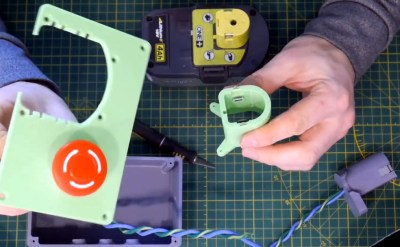 In the videos after the break, [Chris] takes viewers through the design and construction of what he calls the “Sinister Saw”, which is made somewhat more complicated by the fact that he obviously doesn’t have a table saw to begin with. Cutting out the pieces for the table itself and the panels that would eventually become home to the router and circular saw took some careful work with clamps and saw horses to make sure they were all perfectly square.
In the videos after the break, [Chris] takes viewers through the design and construction of what he calls the “Sinister Saw”, which is made somewhat more complicated by the fact that he obviously doesn’t have a table saw to begin with. Cutting out the pieces for the table itself and the panels that would eventually become home to the router and circular saw took some careful work with clamps and saw horses to make sure they were all perfectly square.
But the wooden components of the Sinister Saw are only half of the story. The table is able to extend by way of an aluminum extrusion frame, and there are numerous 3D printed parts involved for which [Chris] has provided the STL files. We particularly like the box that holds the emergency stop button and relocates the tool’s battery to the front panel, which looks to be an evolution of his previous work in 3D printing cordless tool adapters. We could certainly see this part being useful on other projects that utilize these style of batteries.
In the other extreme, where you want to build your own tools and have plenty of space, you could try making everything out of giant slabs of stone.
Continue reading “A Custom Saw Designed For Close Quarters Making”
Equipping A Workshop Using Plywood And Handheld Power Tools
Properly equipping a home workshop for the DIY discipline of your choice can often end up costing more than we would like to admit, and is a never ending process. [JSK-Koubou] is doing exactly that, except he is building almost all of his equipment using plywood, hand-held power tools and a LOT of attention to detail.
As far as we can tell the series really got started with a humble hand-held circular saw guide, with every tool being used to build more tools. So far the list boasts more than 50 different videos of tools built around a drill, circular saw, jigsaw, router, planar or grinder. This includes a wood lathe, drill press, jointer and various drills guides and sanders. The level of precision each tool almost eye watering. He even pulls out a dial gauge on some builds to check alignment. We honestly didn’t know plywood equipment could look this good and work so well. Check out the YouTube playlist after the break to see for yourself.
Previously we also covered [JSK-Koubou]’s set of perfectly tuned wooden speaker enclosures, the craftsmanship is really something to behold. For more impressive homebuilt hardware, take a look at this 8-axis camera crane built by another YouTuber for his home shop. Continue reading “Equipping A Workshop Using Plywood And Handheld Power Tools”



